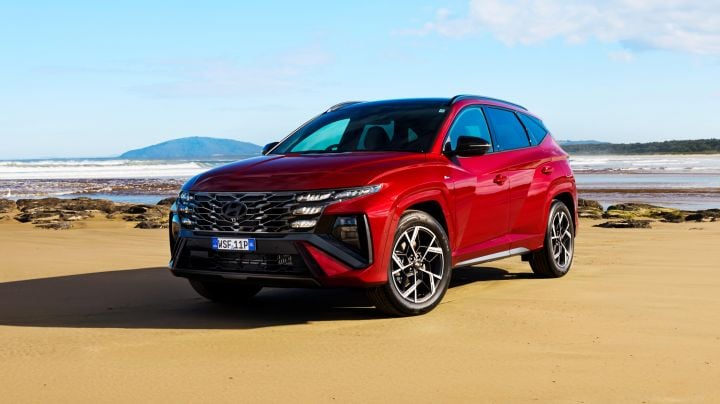

James Wong
2025 Hyundai Tucson review
Pros
- Willing, efficient hybrid powertrain
- Strong value, excellent tech
- Plenty of choice
Cons
- Fuel use creeps up on the highway
- Prices are creeping up too
- Many a beep and bong to annoy
6 Months Ago
The 2025 Hyundai Tucson arrives in Australian showrooms featuring refreshed styling, a newly available hybrid powertrain, and additional equipment, albeit at higher prices.
The turbo-diesel option has been discontinued, replaced by a new hybrid drivetrain, which is shared with the Kia Sportage and offered in both front- and all-wheel drive configurations. The existing 1.6-litre turbocharged four-cylinder engine is also available in both front- and all-wheel drive versions.
The Tucson’s interior has undergone a significant overhaul, now featuring dual 12.3-inch screens – one for the digital instrument cluster and the other for the infotainment system – along with a head-up display, a new climate control panel, and a revised steering wheel. Externally, the Tucson receives a new front bumper and grille design, and LED headlights are now standard across the range, having previously been exclusive to the top-spec Highlander, which the Premium variant has replaced.
Pricing has increased, with the entry-level Hyundai Tucson starting at $39,100 before on-road costs, representing a $3450 increase over the equivalent pre-facelift model. This price rise also applies to the base Tucson Elite, now priced from $44,100 before on-road costs, while the turbocharged, non-hybrid variants that have carried over have seen a price increase of $3950.
The base 2.0-litre naturally aspirated engine is available only in the entry-level Tucson and mid-range Elite variants. At the same time, the turbo-petrol and hybrid powertrains are offered across all three trim levels.
Retail Price
Transmission
6-speed auto
Driven Wheels
4x4 or Front
Fuel Type
Unleaded
Body Types
SUV
Powertrain Type
Combustion or Hybrid
View 6 images
Retail Price
Transmission
6-speed auto
Driven Wheels
4x4 or Front
Fuel Type
Unleaded
Body Types
SUV
Powertrain Type
Combustion or Hybrid
Very Good
5 Reviews
CarExpert does the hard work to get you the best price. No negotiating, no hidden costs, just expert help and real savings on your next new car.
Engine specs, power, and efficiency
Drive Feel: Steering, Suspension, Ride Quality
Strength, stability, and off-road performance
Design, size, and presence on the road
Comfort, tech, and convenience inside
Infotainment, connectivity, and smart features
Protection, prevention, and alerts
Coverage, maintenance, and peace of mind
The Hyundai Tucson comes in a variety of variants with the cheapest being Base and the most expensive being Premium N Line.


James Wong
6 Months Ago
Quickly see how the Hyundai Tucson stacks up against its competition.
Select any benchmark to see more details.
Where expert car reviews meet expert car buying – CarExpert gives you trusted advice, personalised service and real savings on your next new car.
| Specification | Measurement |
|---|---|
| Overall Length | 4,640 mm |
| Overall Width | 1,865 mm |
| Overall Height | 1,665 mm |
| Wheelbase | 2,755 mm |
| Turning Circle | 11,800 mm |
| Load Capacity | 610 mm |
Dimensions in this table show the minimum and maximum values of all variants for this vehicle.
Our Hyundai Tucson Exterior and Dimensions Page has every measurement you need to know exactly how this vehicle will fit your driving, garage, or work needs.





Hyundai Tucson


Derek Fung
4 Months Ago


Damion Smy
4 Months Ago


William Stopford
4 Months Ago
Where expert car reviews meet expert car buying – CarExpert gives you trusted advice, personalised service and real savings on your next new car.
Hyundai Tucson
The cheapest Hyundai Tucson is the Base that starts from $38,100.
See all Hyundai Tucson PricingThe most expensive Hyundai Tucson is the Premium N Line that starts from $59,850.
See all Hyundai Tucson PricingThe best towing capacity of a Hyundai Tucson is 1900 kg offered by the following variants: Base, Elite, Elite N Line, Premium and Premium N Line.
See all Hyundai Tucson towing capacityThe largest Hyundai Tucson is the Elite N Line which measures 1865mm wide, 4650mm in length and sits 1665mm tall.
The most powerful Hyundai Tucson is the Elite N Line which has 172kW of power from its 1.6L Turbo engine.
The Hyundai Tucson is built in Korea and shipped to Australia.
The heaviest Hyundai Tucson is the Elite N Line which weighs 2300 kg (kerb weight).
The Hyundai Tucson uses Unleaded.
# Based on VFACTS and EVC data
* Average savings based on recent CarExpert customer transactions. Actual savings will vary depending on vehicle make and model, location, stock availability, and other factors.
† Displayed prices exclude on-road costs such as delivery charges, registration fees, number plates, insurance and applicable road taxes. These prices are subject to change without notice and may not reflect current market pricing or dealer offers.
 Automotive Vehicle Spec Data & 4K images Powered by JATO Dynamics Ltd
Automotive Vehicle Spec Data & 4K images Powered by JATO Dynamics Ltd